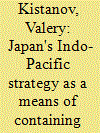|
|
|
Sort Order |
|
|
|
Items / Page
|
|
|
|
|
|
|
| Srl | Item |
| 1 |
ID:
160646


|
|
|
|
|
| Summary/Abstract |
This article analyzes Japan's policy in the basin of the Pacific and Indian Oceans. The term "Indo-Pacific Region" is more often used in scientific circles and mass media now instead of Asia-Pacific Region, which reflects the radical economic and political shifts in the basin of the two oceans. The Indo-Pacific strategy of Premier of Japan Shinzo Abe has an aim to contain the growing economic and military might of China - the main geopolitical rival of Japan in Asia. However, the implementation of this strategy faces difficulties.
|
|
|
|
|
|
|
|
|
|
|
|
|
|
|
|
| 2 |
ID:
182607


|
|
|
|
|
| Summary/Abstract |
India dropped out of the Regional Comprehensive Economic Partnership (RCEP)—which included the Association of Southeast Asian Nations (ASEAN) countries, China, South Korea, New Zealand, Japan and Australia—after negotiating for almost seven years in November 2018 on the grounds of national interest and also that free trade agreements (FTAs) did not amount to free trade and led to more trade diversion than trade creation. The cost and benefit of a regional agreement depend on the amount of trade creation with respect to trade diversion (Panagriya, 2000). This study tries to examine India’s concerns and, at the same time, highlights the cost of not joining RCEP. India’s trade deficit with 11 out of the 15 RCEP nations has been a major cause of concern. Unfavourable trade balance, concerns about the impact on dairy sector, economic slowdown, past experience with FTA’s, China factor, data localisation, rules of origin and the experience of ASEAN countries with Sino-FTA have been some of the reasons behind India’s decision to opt out of this mega multilateral agreement. Also, bilateral trade agreements with some RCEP countries such as Japan, Malaysia, Singapore, Thailand and South Korea were operational. A multilateral trade agreement with ASEAN countries was very much in place. So, trade between India and 12 of the RCEP member countries would not have changed much after India’s inclusion in the RCEP. The impact of lower tariffs would have been evident for the remaining three countries: China, Australia and New Zealand. Furthermore, there was fear of a massive surge in imports of manufactures from China and dairy imports from Australia and New Zealand. This study also examines the long-term impact of this decision and if India has missed out on becoming a part of the global value chain and gaining greater market access in the Asia-Pacific region. India’s policy of import substitution and protectionism did not capitulate desired results in the past. Hence, a critical evaluation of India’s decision and some validation on her concerns and fears have been done.
|
|
|
|
|
|
|
|
|
|
|
|
|
|
|
|
|
|
|
|
|